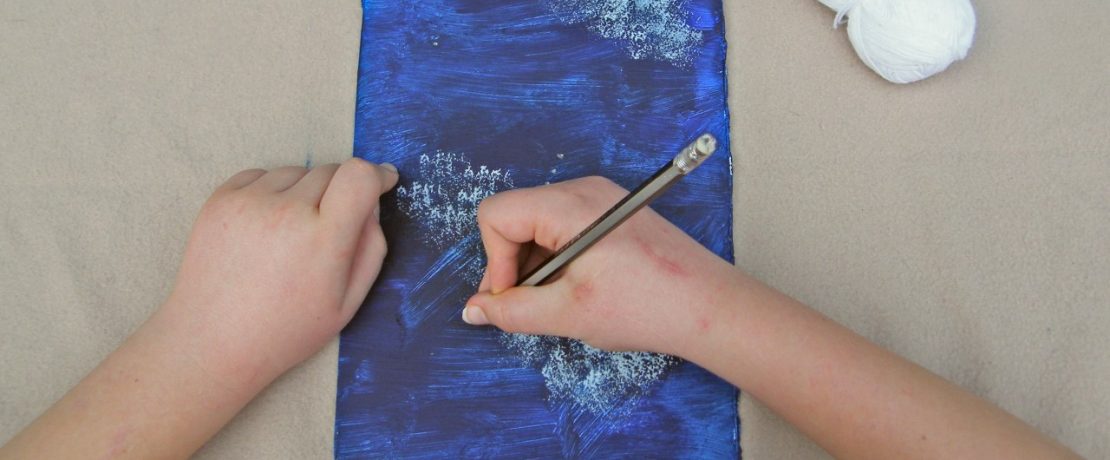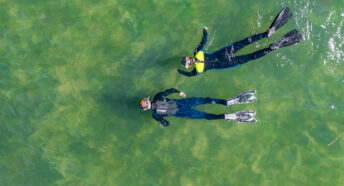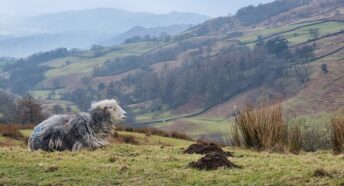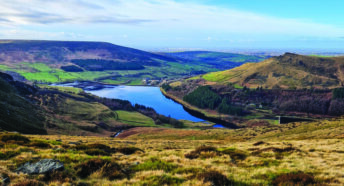Introducing Orion: a stargazing craft activity for families
Crafting expert Kirsty Sullivan suggests ways for kids primary age and up and get crafty to celebrate stargazing and deep, dark skies.
One of my favourite books, when I was young, was The Owl Who Was Afraid of the Dark by Jill Tomlinson. Now I’m a grown-up, I’ve read it to my own children too!
It’s the story of Plop, a baby barn owl, who doesn’t like the dark. His parents send him out every evening to find out more about the dark so he becomes brave enough to fly with them.
One night, the baby barn owl meets an astronomer who shows him the stars. He tells Plop that the dark is wonderful and introduces him to the constellation of Orion the Hunter.
In the story, Plop discovers that dark is many things: fascinating, fun, necessary, beautiful, kind and exciting, but it’s never black. His mother tells him that, ‘It can be silver or blue or grey or lots of other colours but almost never black.’
Do you think Mrs Barn Owl is right? I do.
First: explore the darkness
I love to go outside at night and look at the sky. It’s never the same two nights running: sometimes it’s full of clouds racing past the moon, and on other nights the sky is cold and clear, and you can see thousands of stars. You don’t even need a telescope!
Tonight, why don’t you wrap up warmly and ask your grown-up to take you outside to look at the stars? If you don’t want to go outside, try turning off your lights and looking out of your window. Try opening your window a tiny bit as well, to hear the night sounds.
Let your eyes get used to the dark. Stand quietly, open your ears and see what you can hear. If you’re in a park or a garden, you might hear the rustling of night animals moving through the grass. Even if you’re in a town or city, you may hear a fox bark.
Now your eyes will have adjusted to the dark. It’s time to look up!
Next: eyes to the skies
Look up at the night sky. Describe what you can see to your grown-up.
You might like to write down some descriptive words or phrases, or you could ask your grown-up to write them for you.
Are there any clouds? What colour are they? Where I live, out in the countryside, they look grey against the night sky. Sometimes the moonlight reflects off the clouds and creates a halo of light. If you’re in a town or city, your clouds might look pink or orange because of light pollution from the street lighting.
What colour is the sky itself? It may be deep indigo or dark blue. Again, city light pollution may make it look different.
Now: let’s find some stars!
In the story, the astronomer shows Plop Orion the Hunter. This is a constellation that can be seen all over the world. First, he asks Plop to find three stars close together, which is Orion’s belt. You can find Orion by looking south into the night sky. Then, find the four corner stars which mark the outside of the constellation.
Well done! Are you ready to get creative? We’re going to paint a picture that will help us remember our evening stargazing.
Step one: gather your materials
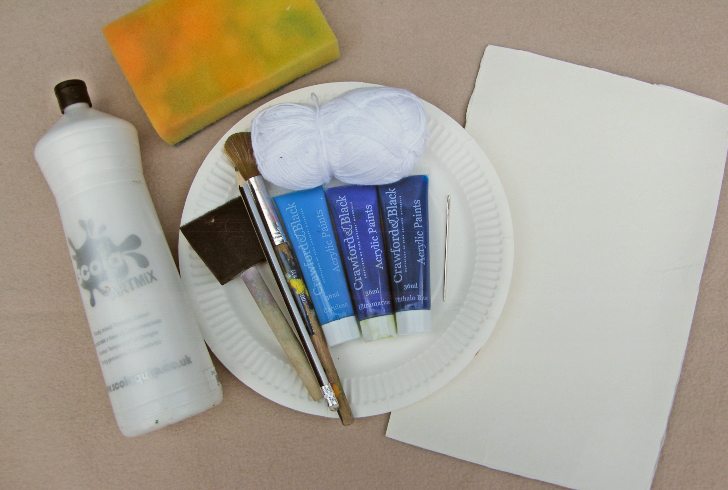
Gather your materials. You’ll need:
- Paints: You’ll need dark colours for the sky and some lighter colours for clouds. Don’t forget that you can mix colours together to get the right shade for your sky. Any paints will do! You could use crayons if you don’t have paints.
- A plate (or piece of cardboard) for mixing colours
- Things to paint with: brushes, and a piece of sponge or crumpled paper
- Something to paint on: the inside of a cereal box would be perfect for this activity. You can make your picture as big or small as you like.
- A sharp pencil or cocktail stick/skewer/needle. Remember to be careful!
- White yarn, thread or string.
Step two: make your sky
Think about your night sky and see if you can mix your paints to get the right colour.
For my sky, I mixed two dark blues with a tiny bit of black to make an even darker shade. Now, using your biggest brush or a sponge, paint your night colour all over your cardboard, and set it on one side to dry.
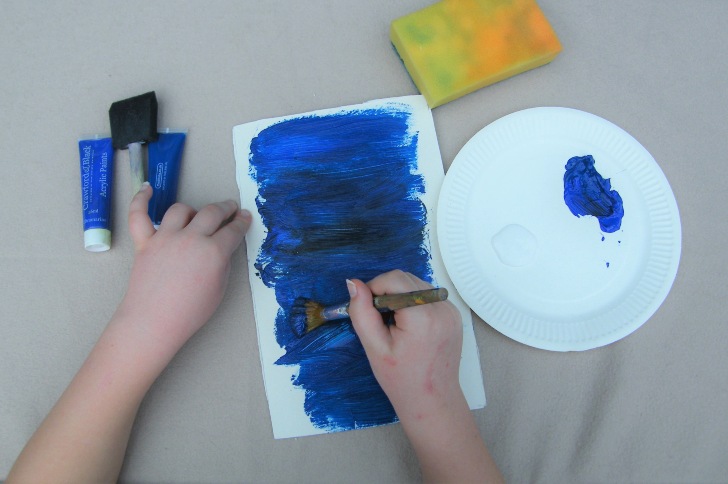
Step three: make your clouds
When your first layer is dry, print your clouds lightly using a piece of sponge or crumpled paper. Set it aside to dry again.
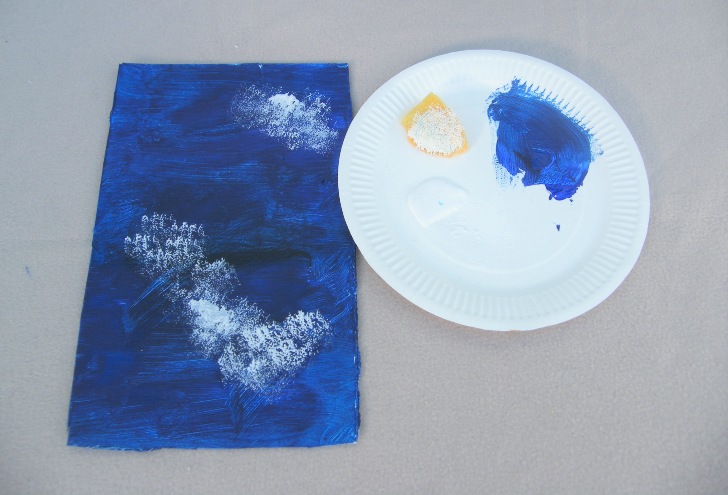
Step four: add the stars
Now we’re going to add Orion. Using a pencil, mark the positions of the three stars of his belt. Then, mark the four corner stars. Using the sharp point of the pencil, a needle or a cocktail stick, carefully poke holes through the cardboard where you have marked the stars.
Step five: add your constellation
Cut a long piece of your yarn or thread and tie a knot in the end. From the back of your painting, push the other end through to the front and pull it until you reach the knot. Use your yarn to join the stars together to ‘draw’ Orion. You may need to use more than one piece of yarn.
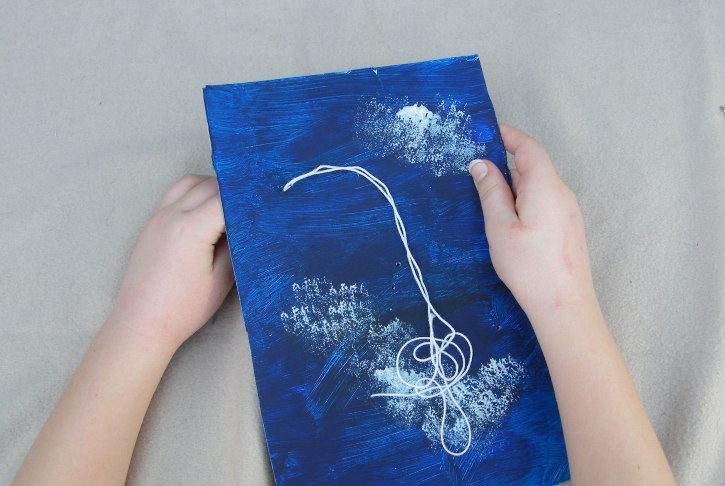
When you have finished, take your yarn through to the back of your painting. Tie a knot as close as you can to the cardboard and cut the tail of the yarn off.
Step six: admire your artwork!
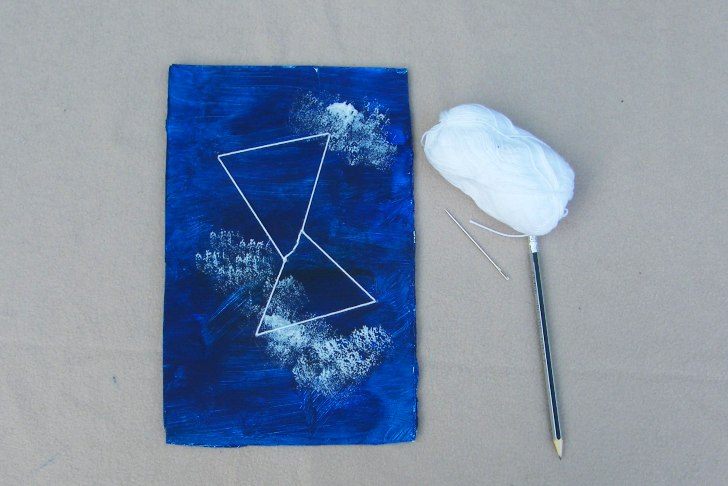
You’re finished! Hang your picture of Orion in the night sky with pride.
Explore more
Want to know more about the stars? Here are some ideas about what to do next:
- Become a citizen scientist and take part in our Star Count each February
- Explore stargazing for beginners: try the BBC Sky at Night YouTube channel
- Try your sky painting activity again on a different night. Do your skies look the same? Can you see different colours?
- Research different constellations and see if you can find them in the sky. Try to find the Big Dipper – this is also known as The Plough, and it’s visible all year near the north pole of the sky.
- Read The Owl Who Was Afraid of the Dark by Jill Tomlinson.
Happy stargazing, Plop and friends!
